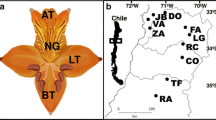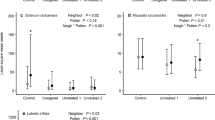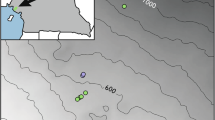Abstract
The pollination syndrome hypothesis has provided a major conceptual framework for how plants and pollinators interact. However, the assumption of specialization in pollination systems and the reliability of floral traits in predicting the main pollinators have been questioned recently. In addition, the relationship between ecological and evolutionary specialization in pollination interactions is still poorly understood. We used data of 62 plant species from three communities across southern Norway to test: (1) the relationships between floral traits and the identity of pollinators, (2) the association between floral traits (evolutionary specialization) and ecological generalization, and (3) the consistency of both relationships across communities. Floral traits significantly affected the identity of pollinators in the three communities in a way consistent with the predictions derived from the pollination syndrome concept. However, hover flies and butterflies visited flowers with different shapes in different communities, which we mainly attribute to among-community variation in pollinator assemblages. Interestingly, ecological generalization depended more on the community-context (i.e. the plant and pollinator assemblages in the communities) than on specific floral traits. While open yellow and white flowers were the most generalist in two communities, they were the most specialist in the alpine community. Our results warn against the use of single measures of ecological generalization to question the pollination syndrome concept, and highlight the importance of community comparisons to assess the pollination syndromes, and to understand the relationships between ecological and evolutionary specialization in plant–pollinator interactions.


Similar content being viewed by others
References
Armbruster WS (2006) Evolutionary and ecological aspects of specialized pollination: views from the Arctic to the Tropics. In: Waser NM, Ollerton J (eds) Plant–pollinator interactions. From specialization to generalization. University of Chicago Press, Chicago, pp 260–282
Bosch J, Retana J, Cerdá X (1997) Flowering phenology, floral traits and pollinator composition in an herbaceous Mediterranean plant community. Oecologia 109:583–591
Brown BJ, Mitchell RJ, Graham SA (2002) Competition for pollination between an invasive species (purple loosestrife) and a native congener. Ecology 83:2328–2336
Chittka L, Waser NM (1997) Why red flowers are not invisible to bees. Israel J Plant Sci 45:169–183
Devoto M, Medan D, Montaldo NH (2005) Patterns of interaction between plants and pollinators along an environmental gradient. Oikos 109:461–472
Dicks LV, Corbet SA, Pywell RF (2002) Compartmentalization in plant–insect flower visitor webs. J Anim Ecol 71:32–43
Faegri K, van der Pijl L (1966) The principles of pollination ecology. Pergamon, Oxford
Fenster CB, Armbruster WS, Wilson P, Dudash MR, Thomson JD (2004) Pollination syndromes and floral specialization. Annu Rev Ecol Evol Syst 35:375–403
Gurevitch J, Scheiner SM, Fox GA (2006) Community properties and mechanisms. In: The ecology of plants, 2nd edn. Sinauer, Sunderland, pp 215–216
Hegland SJ, Totland Ø (2005) Relationships between species’ floral traits and pollinator visitation in a temperate grassland. Oecologia 145:586–594
Herrera CM (1988a) Variation in mutualisms: the spatiotemporal mosaic of a pollinator assemblage. Biol J Linn Soc 35:95–125
Herrera CM (2005) Plant generalization on pollinators: species property or local phenomenon? Am J Bot 92:13–20
Herrera J (1988b) Pollination relationships in southern Spanish Mediterranean shrublands. J Ecol 76:274–287
Hingston AB, McQuillan PB (2000) Are pollination syndromes useful predictors of floral visitors in Tasmania? Austral Ecol 25:600–609
Inouye DW (1978) Resource portioning in bumblebees: experimental studies of foraging behaviour. Ecology 59:672–678
Johnson SD, Steiner KE (2000) Generalization versus specialization in plant pollination systems. Trees 15:140–143
McCall C, Primack RB (1992) Influence of flower characteristics, weather, time of the day, and season on insect visitation rates in three plant communities. Am J Bot 79:434–442
Memmott J (1999) The structure of a plant–pollinator food web. Ecol Lett 2:276–280
Moragues E, Traveset A (2005) Effect of Carpobrotus spp. on the pollination success of native plant species of the Balearic Islands. Biol Conserv 122:611–619
Muchhala N (2006) The pollination biology of Burmeistera (Campanulaceae): specialization and syndromes. Am J Bot 93:1081–1089
Olesen JM, Jordano P (2002) Geographic patterns in plant–pollinator mutualistic networks. Ecology 83:2416–2424
Pellmyr O (2002) Pollination by animals. In: Herrera CM, Pellmyr O (eds) Plant animal–interactions. An evolutionary approach. Blackwell, Great Britain, pp 157–184
Sahley CT (1996) Bat and hummingbird pollination of an autotetraploid columnar cactus, Weberbauerocereus weberbaueri (Cactaceae). Am J Bot 83:1029–1336
Sahli HF, Conner JK (2006) Characterizing ecological generalization in plant–pollination systems. Oecologia 148:365–372
Simpson EH (1949) Measurement of diversity. Nature 163:688
Stang M, Klinkhamer PGL, van der Meijden E (2006) Size constrains and flower abundance determine the number of interactions in a plant-flower visitor web. Oikos 112:111–121
Stebbins GL (1970) Adaptative radiation of reproductive characteristics in angiosperms. 1. Pollination mechanisms. Annu Rev Ecol Evol Syst 1:307–326
Ter Brak CJF, Smilauer P (2002) CANOCO reference manual and CanoDraw for Windows user’s guide: software for canonical community ordination (version 4.5). Microcomputer Power, Ithaca
Valido A, Dupont YL, Hansen DM (2002) Native birds and insects, and introduced honey bees visiting Echinium wildpretii (Boraginaceae) in the Canary Islands. Acta Oecol 23:413–419
Vogel S (1954) Blütenbiologische Typen als Elemente der Sippengliederung, dargestellt anhand der Flora Südafrikas. Bot Stud 1:1–338
Waser NM, Chittka L, Price MV, Williams N, Ollerton J (1996) Generalization in pollination systems, and why it matters. Ecology 77:279–296
Waser NM, Ollerton J (2006) Plant–pollinator interactions. From specialization to generalization. University of Chicago Press, Chicago
Wolfe LM, Sowell DR (2006) Do pollination syndromes partition the pollinator community? A test using four sympatric morning glory species. Int J Plant Sci 167:1169–1175
Acknowledgements
We thank Paul Aakerøy, Sondre Eikås, Vegard Eldholm, Peter Greve, Manuel Hidalgo, Maria Collet Knagenhjelm, Kristian Kyed, Rebekka Lundgren, Kirsten Marthinsen, Torkjell Solbraa, Mari Steinert, Siril Stenerud, Hartvig Velund, Silje Wang, Torstein Wilmot, Knut Frederick Øi, and Magnus Øye for their invaluable help in the field. We are also very grateful to John-Arvid Grytnes and Marcos Méndez for their statistical advice. This study was supported by the projects 170532/V40 and 154185/720, financed by the Norwegian Research Council.
Author information
Authors and Affiliations
Corresponding author
Additional information
Communicated by Florian Schiestl.
Electronic supplementary material
Below is the link to the electronic supplementary material.
442_2008_1066_MOESM1_ESM.doc
Plant species considered in the study, the colour, shape and symmetry (Sy) used in the analyses, the time (hours) used recording pollinators, and the number of pollinator visits recorded. Index of ecological pollinator generalization (PG); main pollinators and their percentage of visits in parentheses. (DOC 176 kb)
Rights and permissions
About this article
Cite this article
Lázaro, A., Hegland, S.J. & Totland, Ø. The relationships between floral traits and specificity of pollination systems in three Scandinavian plant communities. Oecologia 157, 249–257 (2008). https://doi.org/10.1007/s00442-008-1066-2
Received:
Accepted:
Published:
Issue Date:
DOI: https://doi.org/10.1007/s00442-008-1066-2




